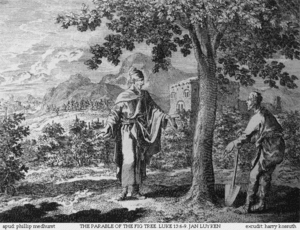Parable of the barren fig tree
The Parable of the Barren Fig Tree (not to be confused with the parable of the budding fig tree) is a parable of Jesus which appears in Luke 13:6-9. It is about a fig tree which does not produce fruit.

Narrative
The parable is as follows:
He spoke also of this parable; A certain man had a fig tree planted in his vineyard; and he came and sought fruit thereon, and found none. Then said he unto the dresser of his vineyard, Behold, these three years I come seeking fruit on this fig tree, and find none: cut it down; why cumbereth it the ground? And he answering said unto him, Lord, let it alone this year also, till I shall dig about it, and dung it: And if it bear fruit, well: and if not, then after that thou shalt cut it down.
— Luke 13:6–9, King James Version
Interpretation
Church Fathers/Catholic/Eastern Orthodox Interpretation The Church Fathers, and the Catholic Church subsequently, has interpreted this parable as Jesus Christ warning Christians that they must bear fruits after their conversion worthy of repentance or risk being condemned to Hell. God, in His mercy, repeatedly checks on believers to see if they have borne fruit worthy of their baptism and conversion. If someone who has been baptized and says they are Christian has not borne fruit, they are condemned. This verse was used during the Counter-Reformation to help support the belief of the Church that faith without works is dead.
Protestant Interpretation In this parable, the owner is generally regarded as representing God the Father, who had a fig tree planted in his vineyard and came seeking fruit. The gardener (vinedresser) is Jesus.[1] Fig trees were common trees and would rarely be planted in vineyards because the deep roots and large branches take much ground that would otherwise be used for the vines.[2]
Another resonance is with Exodus 34:6-7 and Deuteronomy 5:9-10, where God proclaims that he is merciful, gracious and longsuffering - extending mercy to 1,000 generations of those that love Him and obey His instructions, by forgiving their; iniquity, transgression and sin. However, as a righteous judge, He must eventually visit the unforgiven iniquity (which is a different Hebrew word than transgression and sin -Deuteronomy 24:16 ) to the "third or fourth" generation of those that continue to reject Him. The gardener pleads for mercy in the third year/generation and promises to create the best conditions for the fourth year/generation to bear the fruit of repentance before the full consequences of the iniquity would be realised.
The fig tree was a common symbol for Israel and may also have that meaning here,[1] and the tree in the parable may refer to a Christian who has heard the gospel of Christ by faith unto salvation. In either case, the parable reflects Jesus offering a chance for repentance and forgiveness of sin, showing his grace toward his believers.[2] "These three years" logically refers to the period of Jesus' ministry, or simply that is the period it took for a fig tree to bear fruit. The fig tree (gentile) was given the opportunity to be in the vineyard where it otherwise should not have been as well as the needed time to bear fruit. The vinedresser, who is Jesus, does not fail and has offered to cultivate it and so it will produce fruit.
The owner is an absentee landlord, only visiting his vineyard once a year. The law regarding first fruits, Leviticus 19:23-25, forbids eating fruit from a tree in its first three years. The vinedresser has disposed of the fruit, either by plucking it at an early stage or dropping it for compost, to prevent anyone from inadvertently eating the forbidden fruit. The story suggests that the vinedresser is an observant Jew and the owner is a pagan, unfamiliar with the laws of first fruits. Now that the tree is entering its productive period, the vinedresser has saved it from the ax, without letting the master know what happened to the earlier fruit. However, the owner has yet another surprise coming, because in the fourth year, all the fruit is offered to the Lord. Luke may have picked up a Jewish tale of a Jewish laborer outsmarting his pagan master. In the end, the faithful prevail.
Authenticity
Although the parable is found only in Luke's gospel, the other two synoptics include instead the cursing the fig tree with some remarkable coincidences.
There is no strong argument against authenticity. A majority of the members of the Jesus Seminar voted it authentic.[2]
References
- Timothy Maurice Pianzin, Parables of Jesus: In the Light of Its Historical, Geographical & Socio-Cultural Setting, Tate Publishing, 2008, ISBN 1-60247-923-2, pp. 235-237.
- Peter Rhea Jones, Studying the Parables of Jesus, Smyth & Helwys, 1999, ISBN 1-57312-167-3, pp. 123-133.
| Wikimedia Commons has media related to Parable of the Barren Fig Tree. |